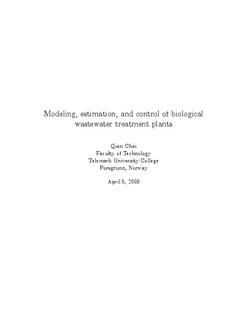| dc.description.abstract | The activated sludge process (ASP), as the most generally applied biological wastewater purification technique, attracts a great deal of attention from the research community in a highly populated, industrialized world. The main objective of this thesis is to investigate methods for e¢ cient development of activated sludge plant models and for possible improvements in process operation and performance through applications of advanced modeling and control techniques. Different topics in advanced control such as parameter estimation, state estimation, and model predictive control, are addressed, and the methods investigated in this thesis are illustrated with two activated sludge processes, a laboratory-scale nitrogen (N) removal plant and a full-scale phosphorus (P) removal plant: the Duvbacken wastewater treatment plant (WWTP).
As model representation is important in control oriented modeling, the object-oriented modeling approach providing open component-based architectures and reuse of components, is suggested in this thesis to achieve a more flexible model representation. The models of the N-removal process and the Duvbacken WWTP are developed based on the Activated Sludge Models (ASMs) which are generally accepted as the standard models of activated sludge processes (ASPs). The dynamic models are implemented in the object-oriented modeling language Modelica using the Dymola simulation environment, based on a modification of the Modelica library WasteWater. In order to build a good software development environment, special consideration is given to two Dymola interfaces: the Dymola-Matlab interface provided by Dymola and the Dymola-Python interface developed by the author. The application of the modeling approach in this thesis shows that the combination of Modelica/Dymola for efficient object-oriented modeling and Matlab for further analysis is a powerful tool for control system design.
The performances of some widely used state estimation techniques, such as the standard Kalman filter (KF), the extended Kalman filter (EKF), the unscented Kalman filter (UKF), the square-root unscented Kalman filter (SRUKF), and the moving horizon estimation (MHE), are evaluated with application to the N-removal process. The comparison of these filters for the N-removal process shows that the SRUKF improves numerical properties of the UKF and provides the best estimation performance, and the discrete-time EKF gives the fastest performance with a satisfactory estimation result. In addition, since a good characterization of the main compositions in the influent is very important to the performance of the ASM models, a method for simultaneously estimating both model state and influent composition (model disturbance) is developed using the discrete-time EKF and illustrated with the Duvbacken WWTP. The filter has a good convergence property for the observable process based on responses from the simulation model. However, when the filter is evaluated based on the experimental data, the performance of the filter is relatively poor due to unobservability of the system. Additional measurements are therefore needed to render the Duvbacken system locally observable.
Parameter estimation of activated sludge plant models is a challenging task, since the models are in general large-scale, nonlinear, and overparameterized. A procedure for parameter identifiability analysis is discussed and tested with the Duvbacken model. This systematic method proves to be very useful, since it reduces a large number of parameters to a small subset of parameters that can be identified from the available experimental data. The fitting of the model to real data from the industrial plant is not great but satisfactory, especially for those outputs which are important to the plant operation (e.g. concentration of phosphate SPO4 and concentration of total phosphorus TP).
Advanced control strategies for the ASP aeration system are suggested with the focus on the MPC algorithm, since MPC provides an optimization-based procedure with an elegant way of handling constraints and with capabilities of removing process disturbances. Both linear and nonlinear MPC techniques are evaluated with the N-removal process, and the simulation results show that the performances of the MPC controllers are satisfactory: the controllers guarantee that the strict e uent requirements are fulfilled. The nonlinear MPC strategy is also compared with some conventional rule-based controllers, and the MPC controller shows the most reduction of the energy consumption and offers the easiest way to handle the inequality constraints.
Finally, recommendations for future research directions are suggested to an N-removal project group at Telemark University College, Norway. | nb_NO |
